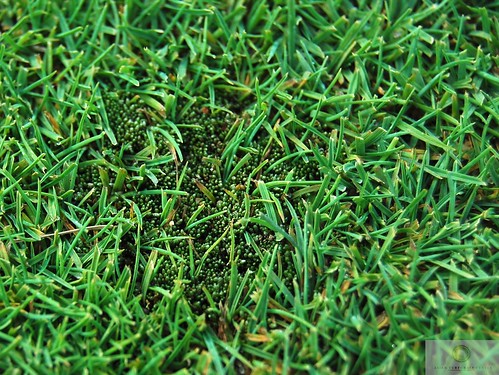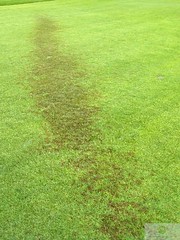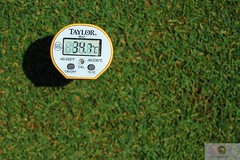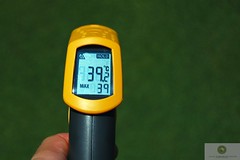 Greetings from the Deep South! I am Maria Tomaso-Peterson, Ph.D and come to you from Mississippi State University where I conduct research and teaching in turfgrass pathology. I am very pleased to be invited by my fellow turfgrass pathologists and bloggers to participate in sharing insights from the Gulf Coast States.
Greetings from the Deep South! I am Maria Tomaso-Peterson, Ph.D and come to you from Mississippi State University where I conduct research and teaching in turfgrass pathology. I am very pleased to be invited by my fellow turfgrass pathologists and bloggers to participate in sharing insights from the Gulf Coast States. The first half of 2011 has been coined the year of extremes…….. no, I am not referring to politics, but to weather conditions across the United States! South of the Interstate 10 corridor, rainfall deficits are making their way into the record books. Our fellow superintendents in Texas are experiencing the driest seven months on record. When I visited New Orleans, LA in May, I was amazed at the drought stress exhibited by the palm trees along Canal St. South Mississippi and Alabama, as well as the panhandle of Florida (the whole state, actually) are well below average for annual rainfall.
With that, fungal disease pressure has not been the issue thus far. The primary challenge is delivering adequate water to keep the turf alive. Of course, the greens are the primary receivers of irrigation, followed by tee boxes, and fairways (sparingly). The roughs have gone dormant, but not to worry, the bermudagrass will be back! Despite the dry conditions, there are still some pest issues that have to be managed. I thought I would share some of those issues with you in my inaugural blog post.
My fellow turf pathologist out of Oklahoma State University, Dr. Damon Smith, had an excellent review on nematodes in creeping bentgrass back in June. As we know, sand-based putting greens are an ideal environment for plant parasitic nematodes; couple that with root zone temperatures above 65 F for the better part of a growing season in the South, one can see how nematode populations can get out of control in one growing season. Sting and root knot nematodes are the most common species identified from dwarf and ultradwarf bermudagrass putting greens. At the Mississippi State University Nematology Laboratory, analysis results have shown bermudagrass green samples with sting in excess of 500 per 100 cc soil and other samples with root knot greater than 1,200 per 100 cc soil. The affected areas of a bermudagrass green may appear light green to yellow, thin turf density, reduced clippings, and the turf does not respond to nitrogen or irrigation. The damage may be widespread but more often observed in clusters. Symptoms of sting damage on bermudagrass roots (left) include root-pruning and necrotic lesions. Root knot galls are easily detected under a stereomicroscope.
Root knot galls are easily detected under a stereomicroscope.
In the photos below, root knot galls can be seen in bermudagrass roots (left) as well as pearly-white, mature female root knot nematodes embedded in a bermudagrass root (right).


For those who stock-piled Nemacur, spot treatment is recommended for control. Curfew® is a soil fumigant which requires a custom applicator and is labeled for use in Mississippi, Alabama, and Florida. Curfew has been granted a 24(c) label from EPA for use on golf courses in Texas and Louisiana. Non-fumigant products, some biologically-based, are also commercially available for nematode control.
Another pest that has been active on drought-stressed turf is the bermudagrass mite (BGM), Eriophyes cynodoniensis, which can be found wherever bermudagrass is grown throughout the United States. Mite injury is most severe to bermudagrass during hot and dry conditions such as those experienced this growing season.
The BGM feeds underneath the leaf sheath. Once feeding commences the leaf tips turn yellow and the leaves beco
feeds underneath the leaf sheath. Once feeding commences the leaf tips turn yellow and the leaves beco me twisted. The internodes shorten resulting in a rosette or witch’s broom appearance. Under severe outbreaks, large areas of turf turn yellow, thin out and may die as a result.
me twisted. The internodes shorten resulting in a rosette or witch’s broom appearance. Under severe outbreaks, large areas of turf turn yellow, thin out and may die as a result.
Insect damage was observed on bermudagrass fairways and roughs earlier this month in Texas. When infestations are high enough to cause obvious symptoms of BGM damage, it is necessary to irrigate the affected turf to minimize damage to the plants. Insecticides are a vailable for BGM control; however repeat applications are necessary to reduce the populations.
vailable for BGM control; however repeat applications are necessary to reduce the populations.
Several locales along the Gulf Coast have received rain over the past week. These localized rain events are a welcome sign for those folks in the drought-stricken regions. The rains drive up the humidity in the turf canopy which in turn is favorable for disease development. I will be scouting the Deep South for disease outbreaks so I can report back to the Turfgrass Disease Blog in the near future. In the meantime, just remember…..never underestimate the power of a fungus!


























































